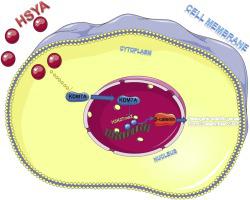The International Journal of Biochemistry & Cell Biology ( IF 4 ) Pub Date : 2021-06-30 , DOI: 10.1016/j.biocel.2021.106033 Peng Wang 1 , Min Wang 2 , Tingling Zhuo 2 , Ying Li 2 , Weiping Lin 3 , Lingli Ding 2 , Meng Zhang 2 , Chi Zhou 4 , Jinfang Zhang 5 , Gang Li 3 , Haibin Wang 4 , Liangliang Xu 4

|
In clinical treatment, there is increasingly prevalent that traditional Chinese medicine treats common bone diseases including osteoporosis. Hydroxysafflor yellow A (HSYA), one of the essential compounds of Safflower, has been used as the therapy for thrombus, myocardial ischemia, and inflammation, but its effect on osteogenesis through epigenetic control and ovariectomy-induced bone loss in vivo has not been explored. Therefore, the study aimed to explore the function and mechanism of HSYA on bone formation and development. We found HSYA could enhance the cell viability and promote osteogenesis of hBMSCs in vitro. Mechanistically, HSYA could increase the expression of β-catenin leading to its accumulation in the nucleus and activation of downstream targets to promote osteogenesis. Besides, RNA-seq and quantitative RT-PCR and western blot showed KDM7A was significantly increased by HSYA. The occupancy of H3K27me2 on β-catenin promoter was significantly decreased by HSYA, which could be reversed by silencing endogenous KDM7A. More importantly, HSYA promoted bone development in chick embryos and prevented ovariectomy (OVX)-induced bone loss in SD rats. Taken together, our study has shown convincing evidence that HSYA could promote osteogenesis and bone development via epigenetically regulating β-catenin and prevent ovariectomy-induced bone loss.
中文翻译:

羟基红花黄 A 通过表观遗传调节 β-catenin 促进成骨和骨骼发育,防止卵巢切除引起的骨质流失
在临床治疗中,中医药治疗骨质疏松等常见骨病越来越普遍。羟基红花黄 A (HSYA) 是红花的必需化合物之一,已被用于治疗血栓、心肌缺血和炎症,但尚未探索其通过表观遗传控制和卵巢切除术引起的体内骨质流失对成骨的影响. 因此,本研究旨在探讨HSYA对骨形成和发育的作用和机制。我们发现HSYA可以增强细胞活力并促进体外hBMSCs的成骨。从机制上讲,HSYA 可以增加 β-catenin 的表达,导致其在细胞核中积累并激活下游靶标以促进成骨。除了,RNA-seq 和定量 RT-PCR 和蛋白质印迹显示 HSYA 显着增加了 KDM7A。H3K27me2 在 β-catenin 启动子上的占有率被 HSYA 显着降低,这可以通过沉默内源性 KDM7A 来逆转。更重要的是,HSYA 促进了鸡胚胎的骨骼发育,并防止了 SD 大鼠卵巢切除术 (OVX) 诱导的骨质流失。总之,我们的研究显示了令人信服的证据,表明 HSYA 可以通过表观遗传调节 β-catenin 促进成骨和骨骼发育,并防止卵巢切除引起的骨质流失。HSYA 促进鸡胚胎的骨骼发育并防止 SD 大鼠卵巢切除术 (OVX) 诱导的骨质流失。总之,我们的研究显示了令人信服的证据,表明 HSYA 可以通过表观遗传调节 β-catenin 促进成骨和骨骼发育,并防止卵巢切除引起的骨质流失。HSYA 促进鸡胚胎的骨骼发育并防止 SD 大鼠卵巢切除术 (OVX) 诱导的骨质流失。总之,我们的研究显示了令人信服的证据,表明 HSYA 可以通过表观遗传调节 β-catenin 促进成骨和骨骼发育,并防止卵巢切除引起的骨质流失。

























 京公网安备 11010802027423号
京公网安备 11010802027423号